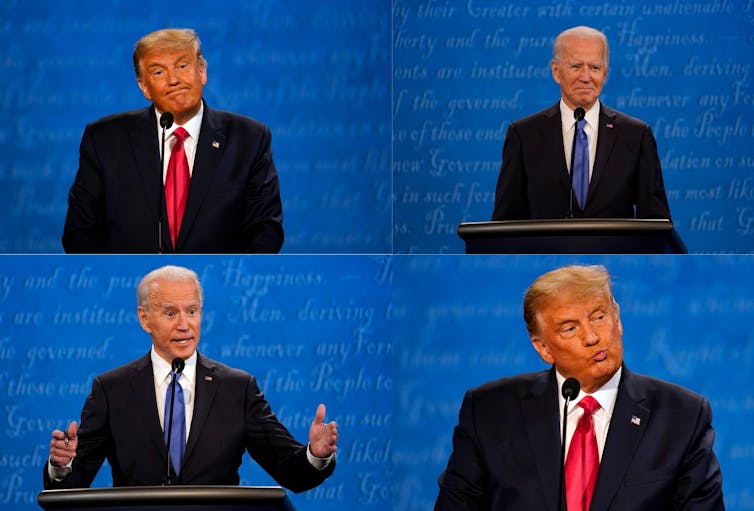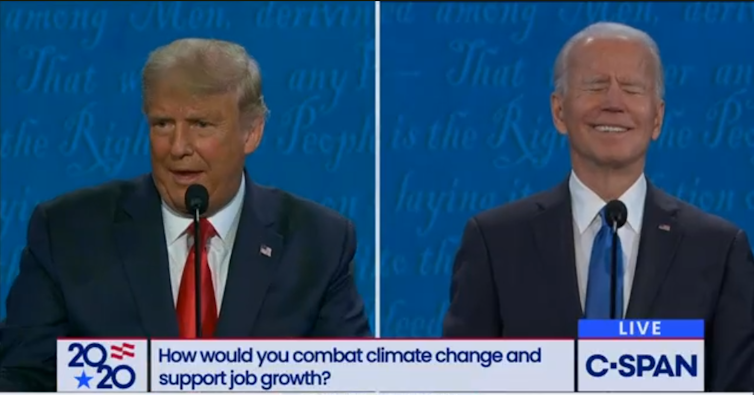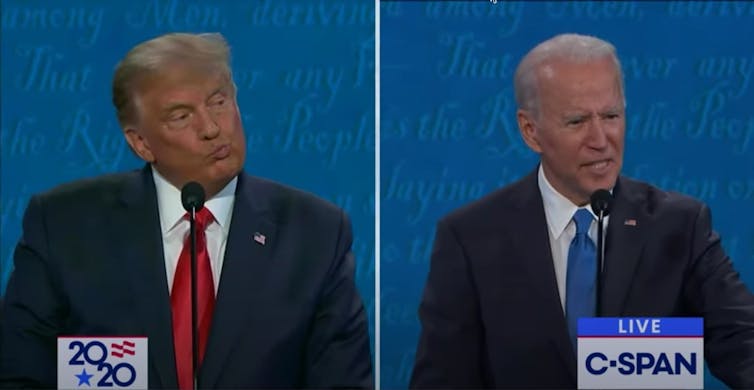I know I was not up to watching last night’s debate, and I doubt TC was either (unless that was why he overslept – probably not, it airs earlier the farther west one lives.) So I’m grateful The Conversation came to my rescue (to the rescue of us all) with this article.
====================================================
An expert in nonverbal communication watched the Trump-Biden debate with the sound turned down – here’s what he saw

AP/Julio Cortez
Patrick Stewart, University of Arkansas
President Donald Trump and former Vice President Joe Biden met on Oct. 22 for the final debate in the 2020 election and, like the first debate, it was unusual.
COVID-19 forced social distancing and largely took the studio audience, with their laughter, cheering and booing out of the equation.
What’s more, with norm-breaking interruptions and stealing of speaking time an inherent part of Donald Trump’s debate strategy, the contentious crosstalk between the two candidates and the moderator made long sections of the candidates’ first debate nearly impossible to hear or follow. The threat of having the microphone cut off effectively muted this aggression.
But is what they say as important as we think?
Although news coverage generally focuses on what the candidates say, as a political psychologist who studies nonverbal behavior, I focus less on the rehearsed answers and more on the space between talking points. These moments, when candidates nonverbally – and largely involuntarily – respond to their opposition can be enormously revealing.
In other words, how people listen and react may speak louder than what they say.
Biden

C-SPAN
During this debate Joe Biden reacted as the emotionally expressive politician he has been throughout his career.
Even when directly dealing with attacks from Trump, whether aimed at his family or his record, Biden often smiled, laughed and shook his head while closing his eyes. That made him appear bemused, if not jovial.
Research suggests that people in informal discussions often change topics within 30 seconds of laughter occurring. This, in turn may be why people – especially politicians – “laugh off” insults.
Laughter when under attack likely signals that Biden feels positive enough to be playful and that he is subtly taking control of the conversation.
Trump

C-SPAN
Trump presented a much less aggressive and more thoughtful face to the American public during this second debate, especially when compared to the first one.
Instead of directly attacking Biden when his assertions were questioned, Trump responded with what may best be termed a controlled-posed smile, in which his lower lip is pressed up while his lip corners were pulled up in a smile. This type of smile is often used to mask negative emotions or to signal positive emotions when they are not felt.
Perhaps Trump’s signature facial display is his protruding funneled lips. This lip funneler – as it is referred to by facial display researchers – can often be seen while Trump is listening and preparing to interrupt or respond to Biden. The research that exists about this behavior in humans suggests it is a primal display often occurring during intense emotional situations and is associated with anger and threats while engaging in dominance-seeking behavior.
Much can be learned about each candidate with the noise turned down and the attention placed squarely on their distinct nonverbal behavior styles.
This is especially the case when focusing on how the candidates respond to their opposition’s assertions and attacks. Public figures can often control how they act. However, they often do not have as much control over how they react in the heat of the moment.
Patrick Stewart, Associate Professor of Political Science, University of Arkansas
This article is republished from The Conversation under a Creative Commons license. Read the original article.
5 Responses to “The Last Debate”
Sorry, the comment form is closed at this time.

Very interesting, and informational.
I wish I had thought of turning down the volume when watching dt.
I usually change the channel if he’s on, or read about him or what he’s said the next day.
With him live & speaking…I just. Can’t.
Thank you, Joanne for posting.
This is a very good perspective and I would say that Stewart was quite accurate. I took courses in communications, verbal and non verbal, at university so I know the value of multiple perspectives. Words can often lie but non verbal communication is not a medium where it is easy to lie.
I didn’t watch, just read the fact-checking in the NYT which told me enough, but from this article, it’s clear that Trump’s body language and especially facial expressions matched the endless list of lies, misinformation, exageration and the usual bigotry in agression and pent-up rage. Biden, on the other hand, apparently had it all under control.
Too bad not everyone can read body language; for some Biden’s control was a sign of an old, tired man. Trump has beaten every little bit of finesse out of any political encounter with his boorish, Neanderthal, alpha-male approach. With apologies to Neanderthals, I read they were far smarter then we were led to believe.
“Too bad not everyone can read body language” – I think almost everone can, but so many read it wrong, and your description is exactly how they misread.
Wonderful Job, JD!